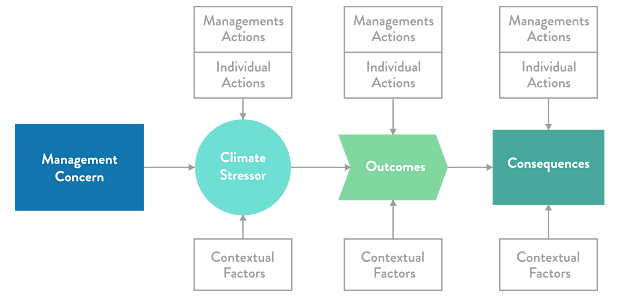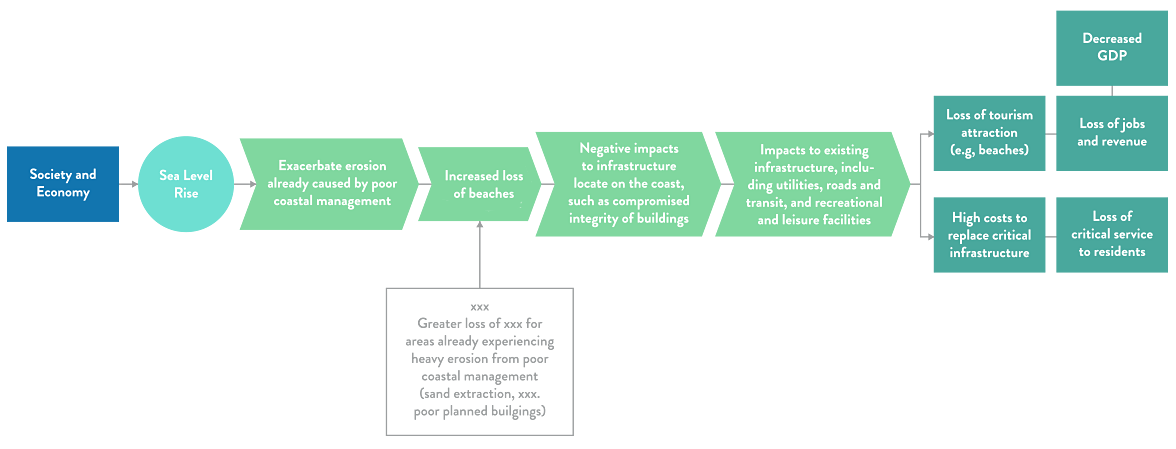Working Group meetings and using VCAPS as a writing tool
Starting in January 2011 working groups began meeting to discuss Puerto Rico’s vulnerabilities to climate change. Early on it became clear that with so many people working on a volunteer basis on such a complex issue a process would be needed that allows for working group members to connect key concepts and find areas of agreement and disagreement quickly and efficiently. At a conference in Chicago, Illinois the PRCCC coordinators were introduced to a tool that could be useful for this purpose. The Vulnerability-Consequence Adaptation Planning Scenarios (VCAPS) process was developed by the Social Environmental Research Institute, the University of South Carolina, the Carolinas Integrated Sciences and Assessments, and the South Carolina Sea Grant Consortium to help community decision-makers, staff, and planners clarify their understanding and assumptions about climate change adaptation challenges their communities will face in the future ((SERI) 2011). A key part of the VCAPS process is the development of diagrams that visually document a group’s discussions in real time. The diagrams illustrate the links between climate hazards or stressors, outcomes, consequences, vulnerabilities, and potential adaptation or mitigation strategies. The diagrams also serve as a library of what a community knows about the unique and special ways that it is vulnerable and resilient to different kinds of climate stressors. Proceeding through the VCAPS process allows the participants to include expertise and knowledge from many aspects of community management, to review the adequacy of knowledge, and to easily spot gaps in knowledge or planning.
Based on the mediated modeling technique, participants in a VCAPS session direct someone from the facilitation team (known as the scribe) through the process of documenting the outcomes and consequences of climate stressors, such as increased temperature, sea level rise, drought, etc. It is somewhat like concept mapping or influence diagramming, although the VCAPS map shows clear chains of cause and effect. See figure 2 for the Building Blocks of VCAPS Diagrams and figures 3 and 4 for examples chains created by the PRCCC’s Society and Economy working group.
The PRCCC Coordinator was trained by the VCAPS process developers and then along with the Working Groups the VCAPS process was modified to the needs of the PRCCC. Each working group member submitted a preliminary, descriptive vulnerability assessment for their topic of expertise and the PRCCC Coordinator placed the information provided in the VCAPS diagrams prior to the start of the meeting. During working group meetings the members would modify the diagrams through facilitated dialogue and the use of the scribes. The working groups connected important concepts and identified areas where more information was needed and where agreements or disagreements existed. One important outcome of the process was a better ability for the working group members to identify reasons why Puerto Rico’s citizens should care about certain chains. These reasons for caring are called consequences in the VCAPS process. Ultimately the VCAPS process allowed for the descriptive vulnerability assessments to be made more complete and understandable.
Figure 1 Building Blocks of VCAPS Diagrams (source: SERI 2011)
Figure 2 One chain of the PRCCC’s Working Group 3 Society and Economy’s diagram for tourism and outdoor recreation. All VCAPS building blocks are included except Management and Individual Actions
Figure 3 One chain of the PRCCC’s Working Group 3 Society and Economy’s diagram for the affects of sea level rise on coastal infrastructure. All VCAPS building blocks are included except Management and Individual Actions



